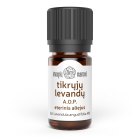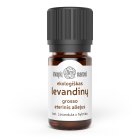Lavender and lavandin
Lavender grows naturally along the Mediterranean and Black Sea coasts, from Spain and the south of France to Bulgaria. French lavender is unanimously recognised as the most precious, for its noble, clean scent and for its particularly strong therapeutic properties. The properties of lavender in Provence are shaped by the microclimate – the sea, sunny skies, brisk springs, low rainfall, the altitude of the mountains, and the specific, very poor soil – limestone... but let's not limit ourselves to that. Discover the variety of lavender and its oils:
- Lavandula angustifolia or L. officinalis, the medicinal or true lavender, which grows from 500 m to almost 2,000 m above sea level. This is the main lavender, the most popular and most widely used. True lavender has been considered a panacea for hundreds of diseases since ancient times.
- Wild true lavender. This is the most special, fragrant lavender growing high in the Alps. The wild true lavender of Provence is extremely rare. We offer you wild lavender hand-picked from wild lavender essential oils from altitudes of 1,200m and higher.
- True lavender is grown from seed or cuttings at altitudes of 800 - 1,200 m above sea level. We offer oils from Provençal varieties (AOP), Mailette, Diva varieties, and lavender oil organically grown in Bulgaria
- Lavandula latifolia, spike lavender. In contrast to its relatives, it is an unremarkable, branched lavender with only a few small flowers, which grows naturally at altitudes of around 500-600m in the Alps. The composition and scent of bell lavender oil is similar to rosemary and eucalyptus, as it contains a significant amount of cineole (eucalyptol).
- Lavandula x intermedia, hybrid lavender, lavandin, which is the result of a cross between the true lavender and the bell lavender in the zone where they grow side by side. Wild lavender is found in the wild and the artificial crossing of the two species has led to the widespread cultivation of cultivated lavender, which is often confused with the true lavender and, especially for inexperienced noses, does not distinguish between true lavender and the essential oils from lavandin. The most commonly cultivated varieties of lavender are Abrial, Super, Sumian, Grosso. The latter is the most commonly cultivated lavender variety, is very productive, accumulates a very high volume of essential oil and is therefore the cheapest lavender essential oil. In Provence, the blue, smooth, ruler-shaped furrows are mostly lavender, not lavender. Non-French traders often do not bother to clarify which lavender or lavandin oil they are selling, and intentional and unintentional forgeries are common.
- Lavandula luisieri, Seville lavender. Not at all like true lavender, Seville lavender oil has an ambrosial scent reminiscent of labdanum with a sweet and fruity note. This is not surprising, as Seville lavender and St. John's wort grow side by side in Andalusia. They are often confused with Italian lavender, but their habitats and scents differ.
- Lavandula stoechas, the Italian lavender, produces very beautiful, characteristic butterfly wing flowers. It is most common on the Mediterranean coast. Rarely distilled in Europe.



